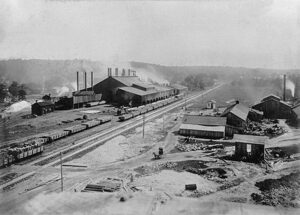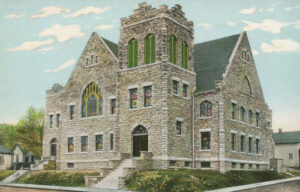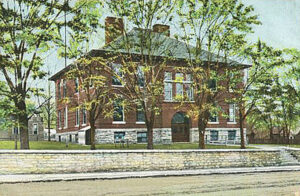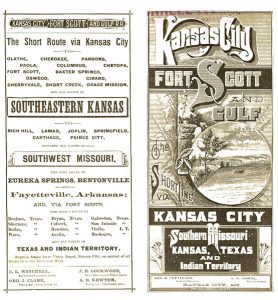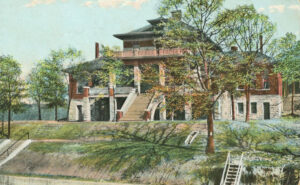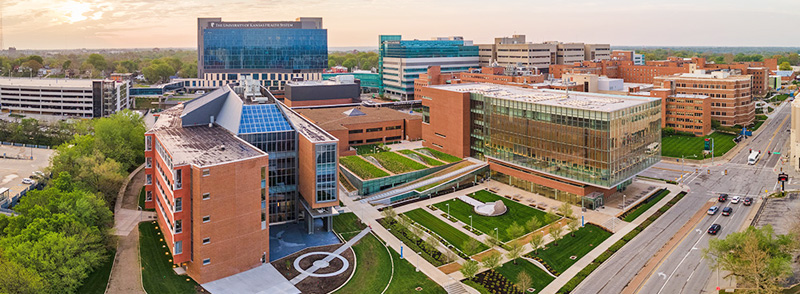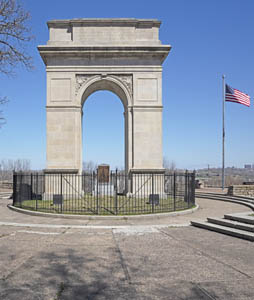Rosedale, Kansas, once a separate municipality, is now a neighborhood of Kansas City, Kansas. It is located in the southeast corner of Wyandotte County and bordered on the north by the Kansas River and the Armourdale neighborhood, on the south by Johnson County, on the west by the Argentine neighborhood, and on the east by the state of Missouri. It is home to the Rosedale World War I Memorial Arch and the University of Kansas Medical Center.
Rosedale, Kansas, was platted in Wyandotte County in 1872 by James G. Brown. However, the building of the town did not begin until 1875, when the roller mills were established.
The Kansas Rolling Mill Company was incorporated in the State of Kansas on April 14, 1875, with A.B. Stone serving as president. The plant was formerly located in Decatur, Illinois, and much of the machinery was shipped by railroad to Rosedale. The plant featured 11 heating furnaces, two hammers, six spike machines, three trains of rolls, and a set of “universal” rolls attached to the 20-inch train. The major product of a Rolling Mill was iron railroad rails that were shaped by rollers. About 100 families came to Rosedale with the Rolling Mill, after which Rosedale became a “boom” town. The Rosedale post office opened on August 19, 1875.
The Catholic Church in Rosedale was organized in 1876, and a church building was erected the following year. However, it was consumed by fire in February 1881. It had, however, previously completed a frame building on Kansas City Avenue and was not without a house of worship.
By 1877, Rosedale had grown sufficiently to be organized as a city of the third class. On August 3 of that year, an election was ordered for the 28th of the month, when D. S. Mathias was elected the first mayor.
Thor Iron Works commenced operations in Rosedale early in the summer of 1878. It was then known as the Kansas Iron Fence Company and was an off-shoot of the Kansas Rolling Mill. The special attention of this company was given to iron fencing of every style and to the manufacturing of all kinds of machinery, including gratings, agriculture implements, and other foundry-cast implements. They also engaged in making bridge castings and girders. The company employed about 75 men, and their monthly payroll was $3,500. Their buildings were located just north of the rolling mill and across the tracks. The general office was at the corner of 6th and Wyandotte Streets in Kansas City, Missouri. Later Thor Iron Works was consolidated with the Rolling Mill.
A Methodist Church was erected in 1881 at an expense of $2,000 on Bluff Street.
The Colored Baptist Society built a church in 1882 valued at $1,000. Previous to the erection of this building, the church held regular service in the schoolhouse.
The town grew rapidly, and as early as 1882, arrangements were made for an excellent waterworks system. The city made arrangements to build an immense reservoir to the south and 150 feet above the level of the streets for the purpose of supplying the town with water. The water was pumped from Turkey Creek, a beautiful natural stream that rushes through the vale in which the town is situated. The ponderous engines at the rolling mills were to pump the water from the creek to the reservoir for the sum of three mills per barrel. Fire hydrants were located throughout the town for the benefit of the city. This was the cheapest and most complete system of water works in the West.
The population that year was 1,800, a fine large school building, many beautiful homes and stores of all kinds had been erected, and it was one of the prosperous towns of the eastern part of the state. It was also described as one of the neatest and most prosperous towns in northeast Kansas.
The University of Kansas School of Medicine can trace its origins back to the “Preparatory Medical Course” offered in 1880. From there, a reputation for scientific discovery, outstanding clinical programs, and an ongoing dedication to community service were built.
In the early 1880s, the city had an elegant school building conveniently located on Kansas City Avenue. The school employed four teachers in the white school and one in the colored department, with an average attendance of 50 scholars.
In the meantime, the Kansas Rolling Mill Company continually made additions to the plant in the next years. By the early 1880s, the mill employed 500 men. They manufactured nearly every variety of railroad supplies, including iron rails and miners, tools, and equipment. They also made many specialty builders’ supplies. The engines aggregated 500 horsepower and, together with the furnaces, consumed 12 carloads of coal per day. The capacity of these mills enabled them to manufacture each week 500 tons of rails, 33,000 splice bars, 270,000 pounds of spikes, and 80,000 pounds of bolts. Their cooper shop on the premises manufactured kegs for spikes and turned out 500 kegs daily.
The company owned about ten tenement houses in the town occupied by employees. A forging shop was connected to the mill, which was operated by a 700-pound steam hammer. Their monthly payroll varied from $10,000 to $25,000, and skilled workmen who worked by the piece realized large wages. These mills manufactured, during the year ending July 1, 13,000 tons of rails; 5,200 tons of splice bars; 4,500 tons of spikes; and 4,000 tons of miscellaneous goods.
In 1879, the Kansas City, Fort Scott, and Gulf Railroad was incorporated, and the Rolling Mill was the railroad’s largest customer at that time. Early records describe the mill, with its roaring furnaces, the clanging noise of the machinery, and flying sparks presenting a colorful show as an attraction for sight-seers.
The Rosedale Coal and Mining Company was established in Rosedale in the fall of 1881. The big iron works used 12 cars of coal a day to keep their 11 furnaces going. A local company was organized for the purpose of mining and furnishing coal for the mill. At a depth of 335 feet, the company struck a 21-inch vein of coal. A short time later, they sunk another shaft that was 75 or 100 feet deeper, where they expected to find a thicker vein. The company employed 18 men at the shaft. The Coal Mine was on the North side of the railroad track, making it necessary to cross the tracks to get the coal from the mine to the mill. However, the railroad would not permit this, as it would have meant a loss of revenue. The Mining Company then tried to convey the coal by an overhead chute, but the railroad stopped this also. Afterward, the mine was sealed at a safe depth and closed.
In 1883, The Kansas Rolling Mill closed due to a depressed economy and financial difficulties due primarily to the railroads changing from iron rails to steel rails. Afterward, the Wyandotte District Court ordered the property of the Kansas Rolling Mill to be sold at a Sheriff’s Sale to the highest bidder. James Parmalee, of Cleveland, Ohio, bid the property at $100,000 in December 1883. The closing of the rolling mill was a big loss to Rosedale as many families moved away. The property stood idle for some time before the Kansas City Wire and Iron Works occupied it. Later the old buildings were torn down. The mill was located about a block north of Kansas City Avenue on Klondike Street, adjacent to the railroad.
By 1897 the area known as Rosedale had a population of over 2,000 inhabitants.
The Rosedale post office closed on July 14, 1902.
The School of Medicine officially opened in September 1905 and began providing instruction at the Bell Memorial Hospital in Rosedale, Kansas. The school lacked clinical facilities, an adequate budget, and political support, but the new school had an impressive corps of talented physician-educators. Its early presence proved to be a springboard toward long-term success.
In 1910, Rosedale was one of the largest cities in Wyandotte County. At that time, it was situated on the St. Louis and San Francisco and Atchison, Topeka & Santa Fe Railroads, four miles southwest of Kansas City. It had an excellent public school system and was the seat of the medical department of the University of Kansas, for which a fine new hospital was erected in 1911 at a cost of over $50,000. There were good stores of all descriptions, several miles of paved streets, excellent water and lighting systems, and an independent branch of the Kansas City post office. All public utilities were provided, and in 1910 the city had a population of 5,960.
Rosedale remained an independent city until it was annexed by Kansas City, Kansas, in 1922.
The Rosedale Arch was dedicated to the men of Rosedale who served in World War I. Inspired by the Arc de Triomphe, the Arch was designed by John LeRoy Marshall, a Rosedale resident. A groundbreaking ceremony held on July 20, 1923, featuring French General Henri Gouraud, was more impressive than the opening ceremony after the arch was completed in 1924.
Located on Mount Marty, the flood-lighted arch is most easily visible at night from the intersection of Rainbow Boulevard and Southwest Boulevard. A historic marker was dedicated under the arch in 1993 to honor the soldiers of World War II, the Korean War, and the Vietnam War.
After decades of disagreements about the school’s location, the new University of Kansas School of Medicine opened in 1924 at 39th Street and Rainbow Boulevard in Kansas City, Kansas.
©Kathy Alexander/Legends of America, June 2023.
Also See:
Wyandotte County Photo Gallery
Sources:
Blackmar, Frank W.; Kansas: A Cyclopedia of State History, Vol I; Standard Publishing Company, Chicago, IL 1912.
Cutler, William G; History of Kansas; A. T. Andreas, Chicago, IL, 1883.
Kansas City, Kansas Public Library
Wikipedia – Memorial Arch
Wikipedia – Rosedale


